EC3323 Monetary Economics Essay: Systematic vs. Non-Systematic Crises
VerifiedAdded on 2023/01/12
|12
|3461
|39
Essay
AI Summary
This essay delves into the realm of monetary economics, specifically examining the relationship between banking crises and financial reforms. The study investigates how systematic and non-systematic banking crises influence financial reforms using an empirical model and OLS regression. The research employs both primary and secondary data, analyzing data from 76 countries. The essay hypothesizes that banking crises significantly affect financial reforms. The results, presented in regression tables, indicate a correlation between the two variables, with adjusted R-values and p-values supporting the hypothesis. The study concludes that both systematic and non-systematic crises have a combined impact on financial reforms, highlighting the need for policy considerations in the face of banking instability. The essay also acknowledges missing elements in the existing literature, such as the intensity of impact of each type of crisis.
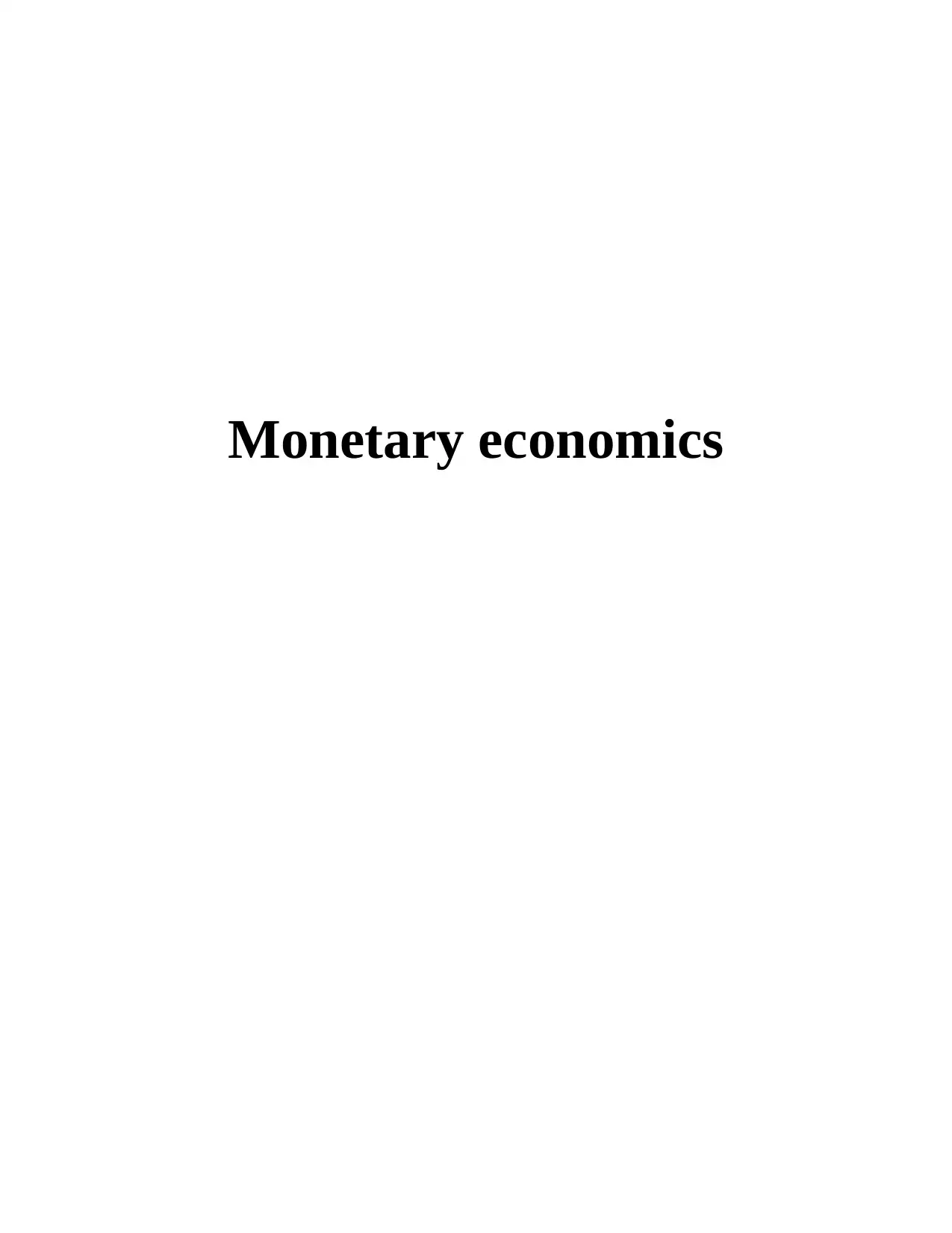
Monetary economics
Paraphrase This Document
Need a fresh take? Get an instant paraphrase of this document with our AI Paraphraser
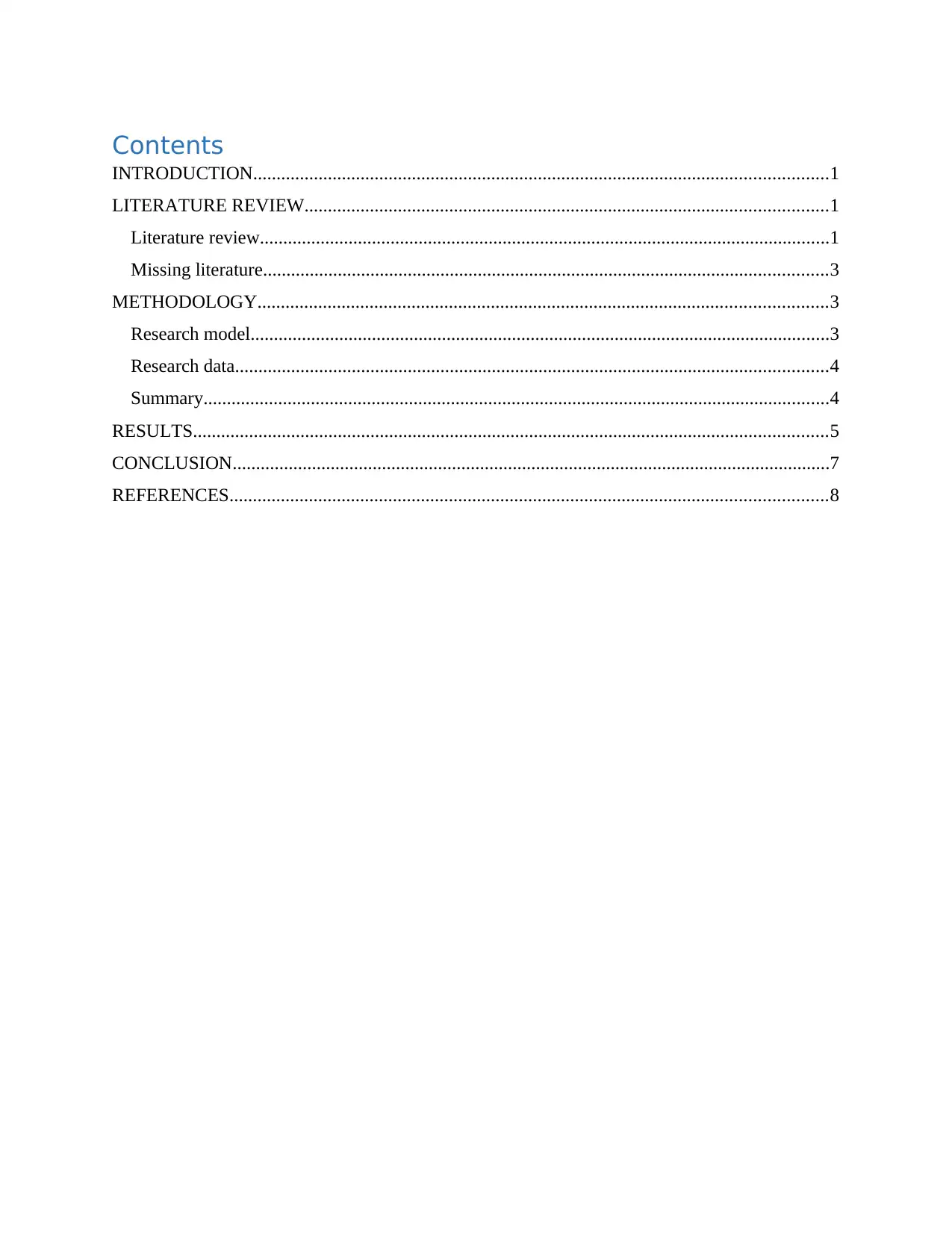
Contents
INTRODUCTION...........................................................................................................................1
LITERATURE REVIEW................................................................................................................1
Literature review..........................................................................................................................1
Missing literature.........................................................................................................................3
METHODOLOGY..........................................................................................................................3
Research model............................................................................................................................3
Research data...............................................................................................................................4
Summary......................................................................................................................................4
RESULTS........................................................................................................................................5
CONCLUSION................................................................................................................................7
REFERENCES................................................................................................................................8
INTRODUCTION...........................................................................................................................1
LITERATURE REVIEW................................................................................................................1
Literature review..........................................................................................................................1
Missing literature.........................................................................................................................3
METHODOLOGY..........................................................................................................................3
Research model............................................................................................................................3
Research data...............................................................................................................................4
Summary......................................................................................................................................4
RESULTS........................................................................................................................................5
CONCLUSION................................................................................................................................7
REFERENCES................................................................................................................................8

⊘ This is a preview!⊘
Do you want full access?
Subscribe today to unlock all pages.

Trusted by 1+ million students worldwide
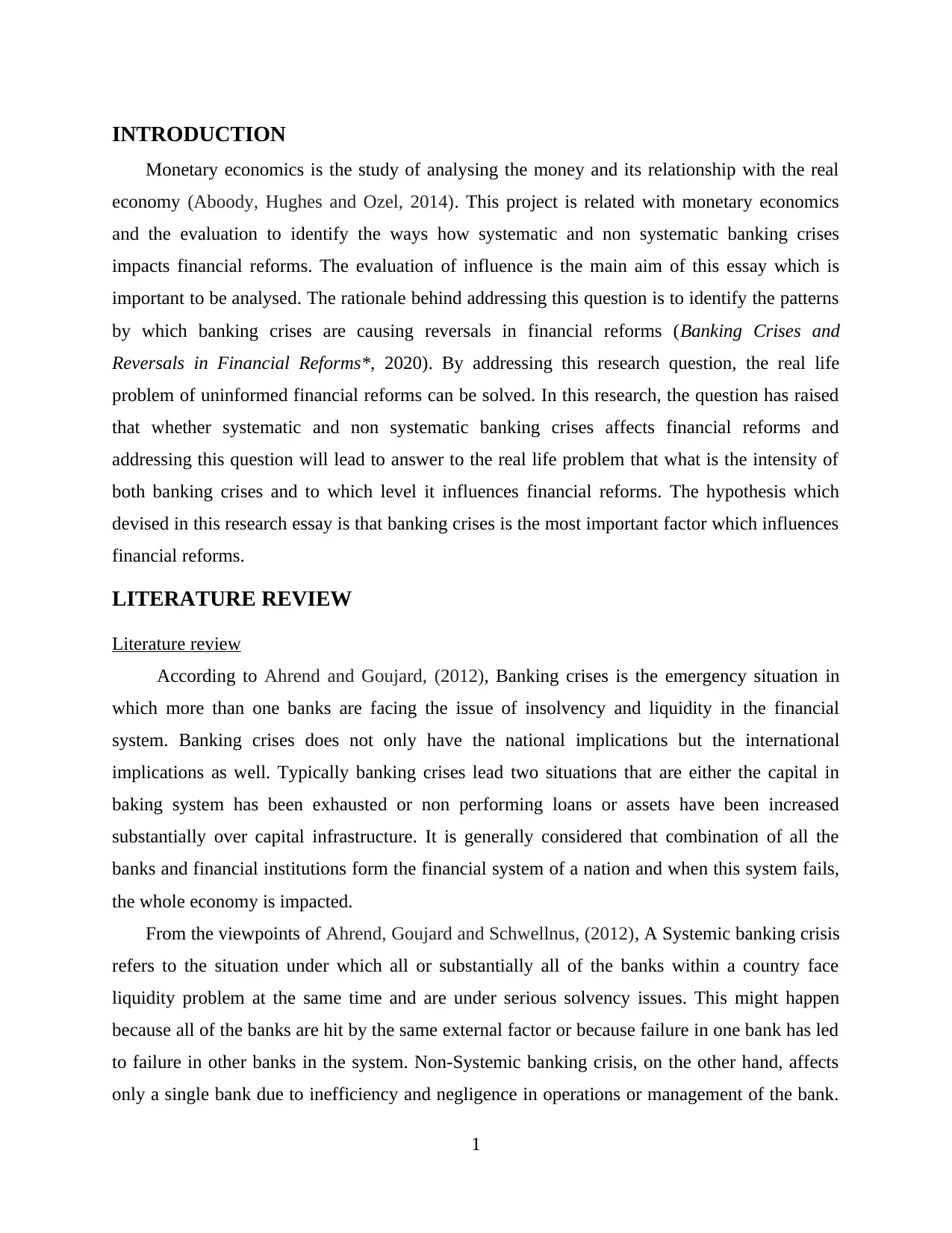
INTRODUCTION
Monetary economics is the study of analysing the money and its relationship with the real
economy (Aboody, Hughes and Ozel, 2014). This project is related with monetary economics
and the evaluation to identify the ways how systematic and non systematic banking crises
impacts financial reforms. The evaluation of influence is the main aim of this essay which is
important to be analysed. The rationale behind addressing this question is to identify the patterns
by which banking crises are causing reversals in financial reforms (Banking Crises and
Reversals in Financial Reforms*, 2020). By addressing this research question, the real life
problem of uninformed financial reforms can be solved. In this research, the question has raised
that whether systematic and non systematic banking crises affects financial reforms and
addressing this question will lead to answer to the real life problem that what is the intensity of
both banking crises and to which level it influences financial reforms. The hypothesis which
devised in this research essay is that banking crises is the most important factor which influences
financial reforms.
LITERATURE REVIEW
Literature review
According to Ahrend and Goujard, (2012), Banking crises is the emergency situation in
which more than one banks are facing the issue of insolvency and liquidity in the financial
system. Banking crises does not only have the national implications but the international
implications as well. Typically banking crises lead two situations that are either the capital in
baking system has been exhausted or non performing loans or assets have been increased
substantially over capital infrastructure. It is generally considered that combination of all the
banks and financial institutions form the financial system of a nation and when this system fails,
the whole economy is impacted.
From the viewpoints of Ahrend, Goujard and Schwellnus, (2012), A Systemic banking crisis
refers to the situation under which all or substantially all of the banks within a country face
liquidity problem at the same time and are under serious solvency issues. This might happen
because all of the banks are hit by the same external factor or because failure in one bank has led
to failure in other banks in the system. Non-Systemic banking crisis, on the other hand, affects
only a single bank due to inefficiency and negligence in operations or management of the bank.
1
Monetary economics is the study of analysing the money and its relationship with the real
economy (Aboody, Hughes and Ozel, 2014). This project is related with monetary economics
and the evaluation to identify the ways how systematic and non systematic banking crises
impacts financial reforms. The evaluation of influence is the main aim of this essay which is
important to be analysed. The rationale behind addressing this question is to identify the patterns
by which banking crises are causing reversals in financial reforms (Banking Crises and
Reversals in Financial Reforms*, 2020). By addressing this research question, the real life
problem of uninformed financial reforms can be solved. In this research, the question has raised
that whether systematic and non systematic banking crises affects financial reforms and
addressing this question will lead to answer to the real life problem that what is the intensity of
both banking crises and to which level it influences financial reforms. The hypothesis which
devised in this research essay is that banking crises is the most important factor which influences
financial reforms.
LITERATURE REVIEW
Literature review
According to Ahrend and Goujard, (2012), Banking crises is the emergency situation in
which more than one banks are facing the issue of insolvency and liquidity in the financial
system. Banking crises does not only have the national implications but the international
implications as well. Typically banking crises lead two situations that are either the capital in
baking system has been exhausted or non performing loans or assets have been increased
substantially over capital infrastructure. It is generally considered that combination of all the
banks and financial institutions form the financial system of a nation and when this system fails,
the whole economy is impacted.
From the viewpoints of Ahrend, Goujard and Schwellnus, (2012), A Systemic banking crisis
refers to the situation under which all or substantially all of the banks within a country face
liquidity problem at the same time and are under serious solvency issues. This might happen
because all of the banks are hit by the same external factor or because failure in one bank has led
to failure in other banks in the system. Non-Systemic banking crisis, on the other hand, affects
only a single bank due to inefficiency and negligence in operations or management of the bank.
1
Paraphrase This Document
Need a fresh take? Get an instant paraphrase of this document with our AI Paraphraser
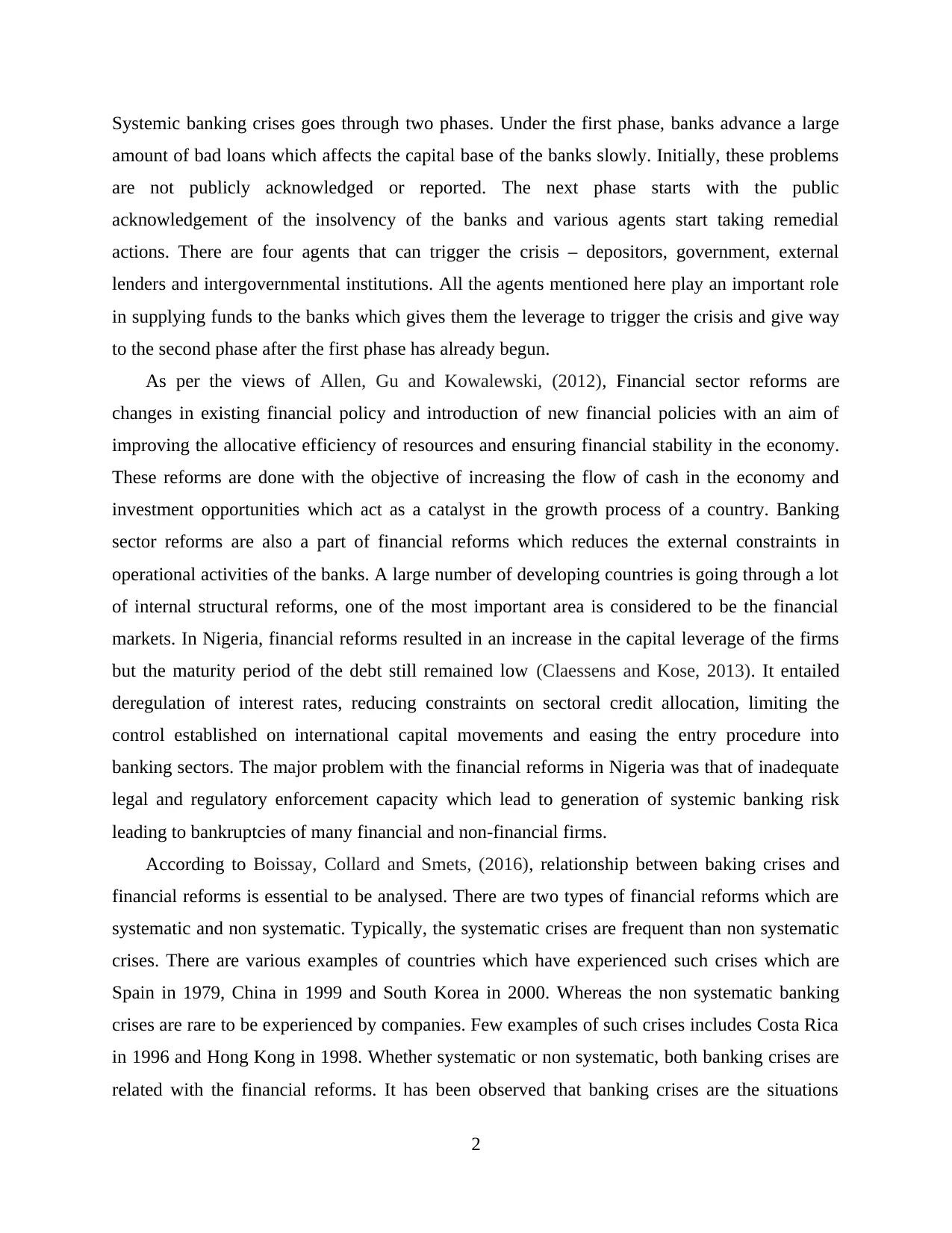
Systemic banking crises goes through two phases. Under the first phase, banks advance a large
amount of bad loans which affects the capital base of the banks slowly. Initially, these problems
are not publicly acknowledged or reported. The next phase starts with the public
acknowledgement of the insolvency of the banks and various agents start taking remedial
actions. There are four agents that can trigger the crisis – depositors, government, external
lenders and intergovernmental institutions. All the agents mentioned here play an important role
in supplying funds to the banks which gives them the leverage to trigger the crisis and give way
to the second phase after the first phase has already begun.
As per the views of Allen, Gu and Kowalewski, (2012), Financial sector reforms are
changes in existing financial policy and introduction of new financial policies with an aim of
improving the allocative efficiency of resources and ensuring financial stability in the economy.
These reforms are done with the objective of increasing the flow of cash in the economy and
investment opportunities which act as a catalyst in the growth process of a country. Banking
sector reforms are also a part of financial reforms which reduces the external constraints in
operational activities of the banks. A large number of developing countries is going through a lot
of internal structural reforms, one of the most important area is considered to be the financial
markets. In Nigeria, financial reforms resulted in an increase in the capital leverage of the firms
but the maturity period of the debt still remained low (Claessens and Kose, 2013). It entailed
deregulation of interest rates, reducing constraints on sectoral credit allocation, limiting the
control established on international capital movements and easing the entry procedure into
banking sectors. The major problem with the financial reforms in Nigeria was that of inadequate
legal and regulatory enforcement capacity which lead to generation of systemic banking risk
leading to bankruptcies of many financial and non-financial firms.
According to Boissay, Collard and Smets, (2016), relationship between baking crises and
financial reforms is essential to be analysed. There are two types of financial reforms which are
systematic and non systematic. Typically, the systematic crises are frequent than non systematic
crises. There are various examples of countries which have experienced such crises which are
Spain in 1979, China in 1999 and South Korea in 2000. Whereas the non systematic banking
crises are rare to be experienced by companies. Few examples of such crises includes Costa Rica
in 1996 and Hong Kong in 1998. Whether systematic or non systematic, both banking crises are
related with the financial reforms. It has been observed that banking crises are the situations
2
amount of bad loans which affects the capital base of the banks slowly. Initially, these problems
are not publicly acknowledged or reported. The next phase starts with the public
acknowledgement of the insolvency of the banks and various agents start taking remedial
actions. There are four agents that can trigger the crisis – depositors, government, external
lenders and intergovernmental institutions. All the agents mentioned here play an important role
in supplying funds to the banks which gives them the leverage to trigger the crisis and give way
to the second phase after the first phase has already begun.
As per the views of Allen, Gu and Kowalewski, (2012), Financial sector reforms are
changes in existing financial policy and introduction of new financial policies with an aim of
improving the allocative efficiency of resources and ensuring financial stability in the economy.
These reforms are done with the objective of increasing the flow of cash in the economy and
investment opportunities which act as a catalyst in the growth process of a country. Banking
sector reforms are also a part of financial reforms which reduces the external constraints in
operational activities of the banks. A large number of developing countries is going through a lot
of internal structural reforms, one of the most important area is considered to be the financial
markets. In Nigeria, financial reforms resulted in an increase in the capital leverage of the firms
but the maturity period of the debt still remained low (Claessens and Kose, 2013). It entailed
deregulation of interest rates, reducing constraints on sectoral credit allocation, limiting the
control established on international capital movements and easing the entry procedure into
banking sectors. The major problem with the financial reforms in Nigeria was that of inadequate
legal and regulatory enforcement capacity which lead to generation of systemic banking risk
leading to bankruptcies of many financial and non-financial firms.
According to Boissay, Collard and Smets, (2016), relationship between baking crises and
financial reforms is essential to be analysed. There are two types of financial reforms which are
systematic and non systematic. Typically, the systematic crises are frequent than non systematic
crises. There are various examples of countries which have experienced such crises which are
Spain in 1979, China in 1999 and South Korea in 2000. Whereas the non systematic banking
crises are rare to be experienced by companies. Few examples of such crises includes Costa Rica
in 1996 and Hong Kong in 1998. Whether systematic or non systematic, both banking crises are
related with the financial reforms. It has been observed that banking crises are the situations
2
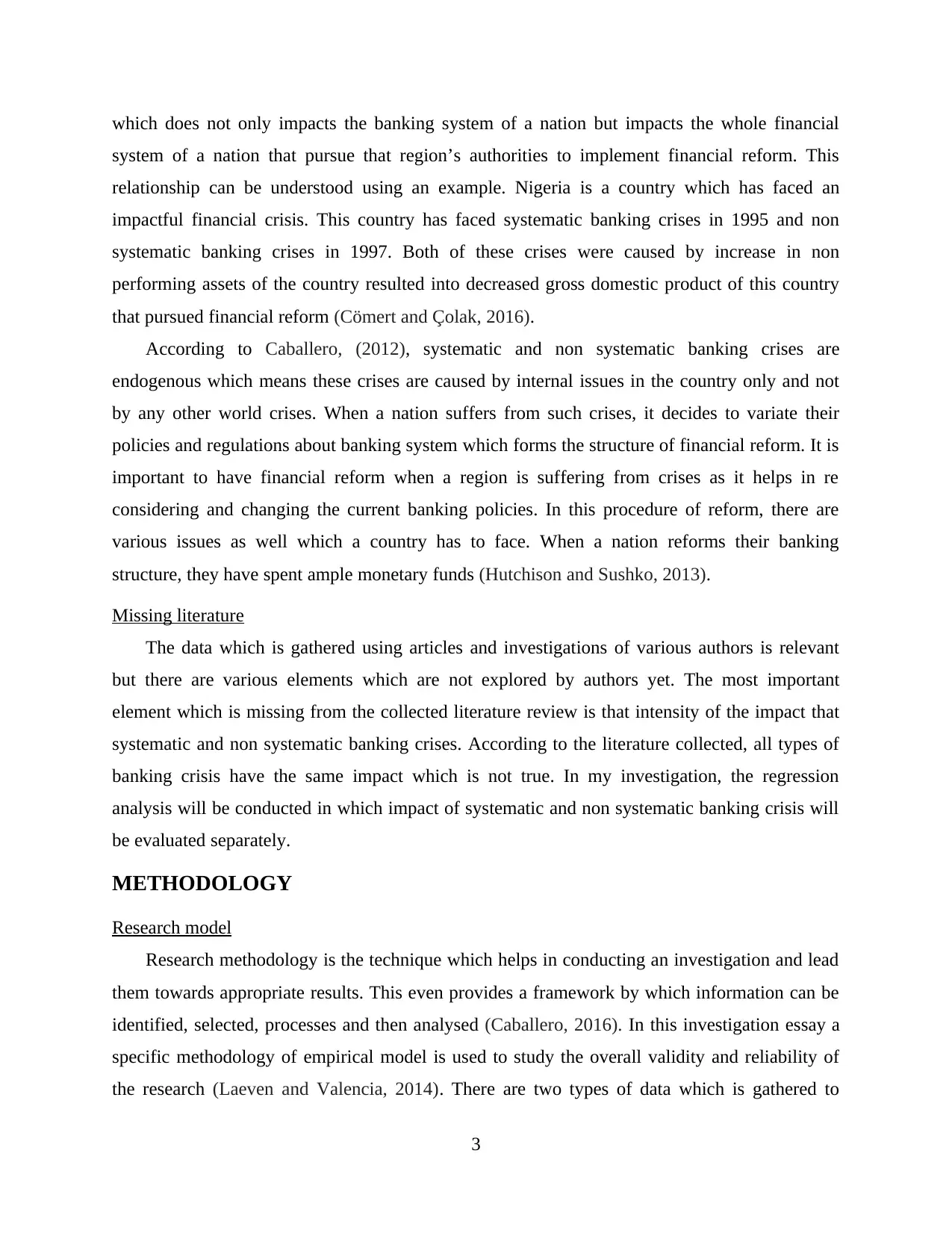
which does not only impacts the banking system of a nation but impacts the whole financial
system of a nation that pursue that region’s authorities to implement financial reform. This
relationship can be understood using an example. Nigeria is a country which has faced an
impactful financial crisis. This country has faced systematic banking crises in 1995 and non
systematic banking crises in 1997. Both of these crises were caused by increase in non
performing assets of the country resulted into decreased gross domestic product of this country
that pursued financial reform (Cömert and Çolak, 2016).
According to Caballero, (2012), systematic and non systematic banking crises are
endogenous which means these crises are caused by internal issues in the country only and not
by any other world crises. When a nation suffers from such crises, it decides to variate their
policies and regulations about banking system which forms the structure of financial reform. It is
important to have financial reform when a region is suffering from crises as it helps in re
considering and changing the current banking policies. In this procedure of reform, there are
various issues as well which a country has to face. When a nation reforms their banking
structure, they have spent ample monetary funds (Hutchison and Sushko, 2013).
Missing literature
The data which is gathered using articles and investigations of various authors is relevant
but there are various elements which are not explored by authors yet. The most important
element which is missing from the collected literature review is that intensity of the impact that
systematic and non systematic banking crises. According to the literature collected, all types of
banking crisis have the same impact which is not true. In my investigation, the regression
analysis will be conducted in which impact of systematic and non systematic banking crisis will
be evaluated separately.
METHODOLOGY
Research model
Research methodology is the technique which helps in conducting an investigation and lead
them towards appropriate results. This even provides a framework by which information can be
identified, selected, processes and then analysed (Caballero, 2016). In this investigation essay a
specific methodology of empirical model is used to study the overall validity and reliability of
the research (Laeven and Valencia, 2014). There are two types of data which is gathered to
3
system of a nation that pursue that region’s authorities to implement financial reform. This
relationship can be understood using an example. Nigeria is a country which has faced an
impactful financial crisis. This country has faced systematic banking crises in 1995 and non
systematic banking crises in 1997. Both of these crises were caused by increase in non
performing assets of the country resulted into decreased gross domestic product of this country
that pursued financial reform (Cömert and Çolak, 2016).
According to Caballero, (2012), systematic and non systematic banking crises are
endogenous which means these crises are caused by internal issues in the country only and not
by any other world crises. When a nation suffers from such crises, it decides to variate their
policies and regulations about banking system which forms the structure of financial reform. It is
important to have financial reform when a region is suffering from crises as it helps in re
considering and changing the current banking policies. In this procedure of reform, there are
various issues as well which a country has to face. When a nation reforms their banking
structure, they have spent ample monetary funds (Hutchison and Sushko, 2013).
Missing literature
The data which is gathered using articles and investigations of various authors is relevant
but there are various elements which are not explored by authors yet. The most important
element which is missing from the collected literature review is that intensity of the impact that
systematic and non systematic banking crises. According to the literature collected, all types of
banking crisis have the same impact which is not true. In my investigation, the regression
analysis will be conducted in which impact of systematic and non systematic banking crisis will
be evaluated separately.
METHODOLOGY
Research model
Research methodology is the technique which helps in conducting an investigation and lead
them towards appropriate results. This even provides a framework by which information can be
identified, selected, processes and then analysed (Caballero, 2016). In this investigation essay a
specific methodology of empirical model is used to study the overall validity and reliability of
the research (Laeven and Valencia, 2014). There are two types of data which is gathered to
3
⊘ This is a preview!⊘
Do you want full access?
Subscribe today to unlock all pages.

Trusted by 1+ million students worldwide
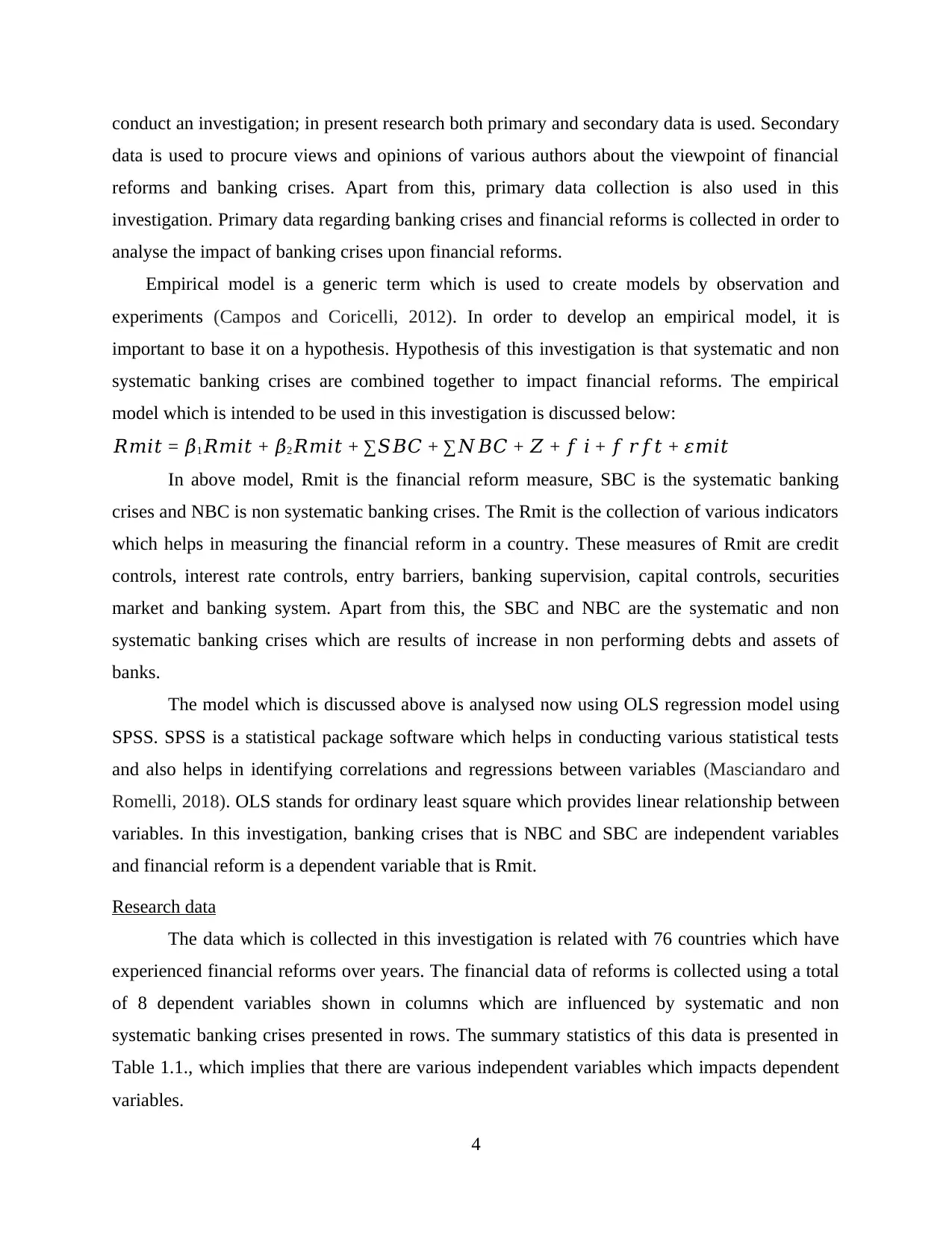
conduct an investigation; in present research both primary and secondary data is used. Secondary
data is used to procure views and opinions of various authors about the viewpoint of financial
reforms and banking crises. Apart from this, primary data collection is also used in this
investigation. Primary data regarding banking crises and financial reforms is collected in order to
analyse the impact of banking crises upon financial reforms.
Empirical model is a generic term which is used to create models by observation and
experiments (Campos and Coricelli, 2012). In order to develop an empirical model, it is
important to base it on a hypothesis. Hypothesis of this investigation is that systematic and non
systematic banking crises are combined together to impact financial reforms. The empirical
model which is intended to be used in this investigation is discussed below:
𝑅𝑚𝑖𝑡 = 𝛽1𝑅𝑚𝑖𝑡 + 𝛽2𝑅𝑚𝑖𝑡 + ∑𝑆𝐵𝐶 + ∑𝑁𝐵𝐶 + 𝑍 + 𝑓 𝑖 + 𝑓 𝑟𝑓𝑡 + 𝜀𝑚𝑖𝑡
In above model, Rmit is the financial reform measure, SBC is the systematic banking
crises and NBC is non systematic banking crises. The Rmit is the collection of various indicators
which helps in measuring the financial reform in a country. These measures of Rmit are credit
controls, interest rate controls, entry barriers, banking supervision, capital controls, securities
market and banking system. Apart from this, the SBC and NBC are the systematic and non
systematic banking crises which are results of increase in non performing debts and assets of
banks.
The model which is discussed above is analysed now using OLS regression model using
SPSS. SPSS is a statistical package software which helps in conducting various statistical tests
and also helps in identifying correlations and regressions between variables (Masciandaro and
Romelli, 2018). OLS stands for ordinary least square which provides linear relationship between
variables. In this investigation, banking crises that is NBC and SBC are independent variables
and financial reform is a dependent variable that is Rmit.
Research data
The data which is collected in this investigation is related with 76 countries which have
experienced financial reforms over years. The financial data of reforms is collected using a total
of 8 dependent variables shown in columns which are influenced by systematic and non
systematic banking crises presented in rows. The summary statistics of this data is presented in
Table 1.1., which implies that there are various independent variables which impacts dependent
variables.
4
data is used to procure views and opinions of various authors about the viewpoint of financial
reforms and banking crises. Apart from this, primary data collection is also used in this
investigation. Primary data regarding banking crises and financial reforms is collected in order to
analyse the impact of banking crises upon financial reforms.
Empirical model is a generic term which is used to create models by observation and
experiments (Campos and Coricelli, 2012). In order to develop an empirical model, it is
important to base it on a hypothesis. Hypothesis of this investigation is that systematic and non
systematic banking crises are combined together to impact financial reforms. The empirical
model which is intended to be used in this investigation is discussed below:
𝑅𝑚𝑖𝑡 = 𝛽1𝑅𝑚𝑖𝑡 + 𝛽2𝑅𝑚𝑖𝑡 + ∑𝑆𝐵𝐶 + ∑𝑁𝐵𝐶 + 𝑍 + 𝑓 𝑖 + 𝑓 𝑟𝑓𝑡 + 𝜀𝑚𝑖𝑡
In above model, Rmit is the financial reform measure, SBC is the systematic banking
crises and NBC is non systematic banking crises. The Rmit is the collection of various indicators
which helps in measuring the financial reform in a country. These measures of Rmit are credit
controls, interest rate controls, entry barriers, banking supervision, capital controls, securities
market and banking system. Apart from this, the SBC and NBC are the systematic and non
systematic banking crises which are results of increase in non performing debts and assets of
banks.
The model which is discussed above is analysed now using OLS regression model using
SPSS. SPSS is a statistical package software which helps in conducting various statistical tests
and also helps in identifying correlations and regressions between variables (Masciandaro and
Romelli, 2018). OLS stands for ordinary least square which provides linear relationship between
variables. In this investigation, banking crises that is NBC and SBC are independent variables
and financial reform is a dependent variable that is Rmit.
Research data
The data which is collected in this investigation is related with 76 countries which have
experienced financial reforms over years. The financial data of reforms is collected using a total
of 8 dependent variables shown in columns which are influenced by systematic and non
systematic banking crises presented in rows. The summary statistics of this data is presented in
Table 1.1., which implies that there are various independent variables which impacts dependent
variables.
4
Paraphrase This Document
Need a fresh take? Get an instant paraphrase of this document with our AI Paraphraser
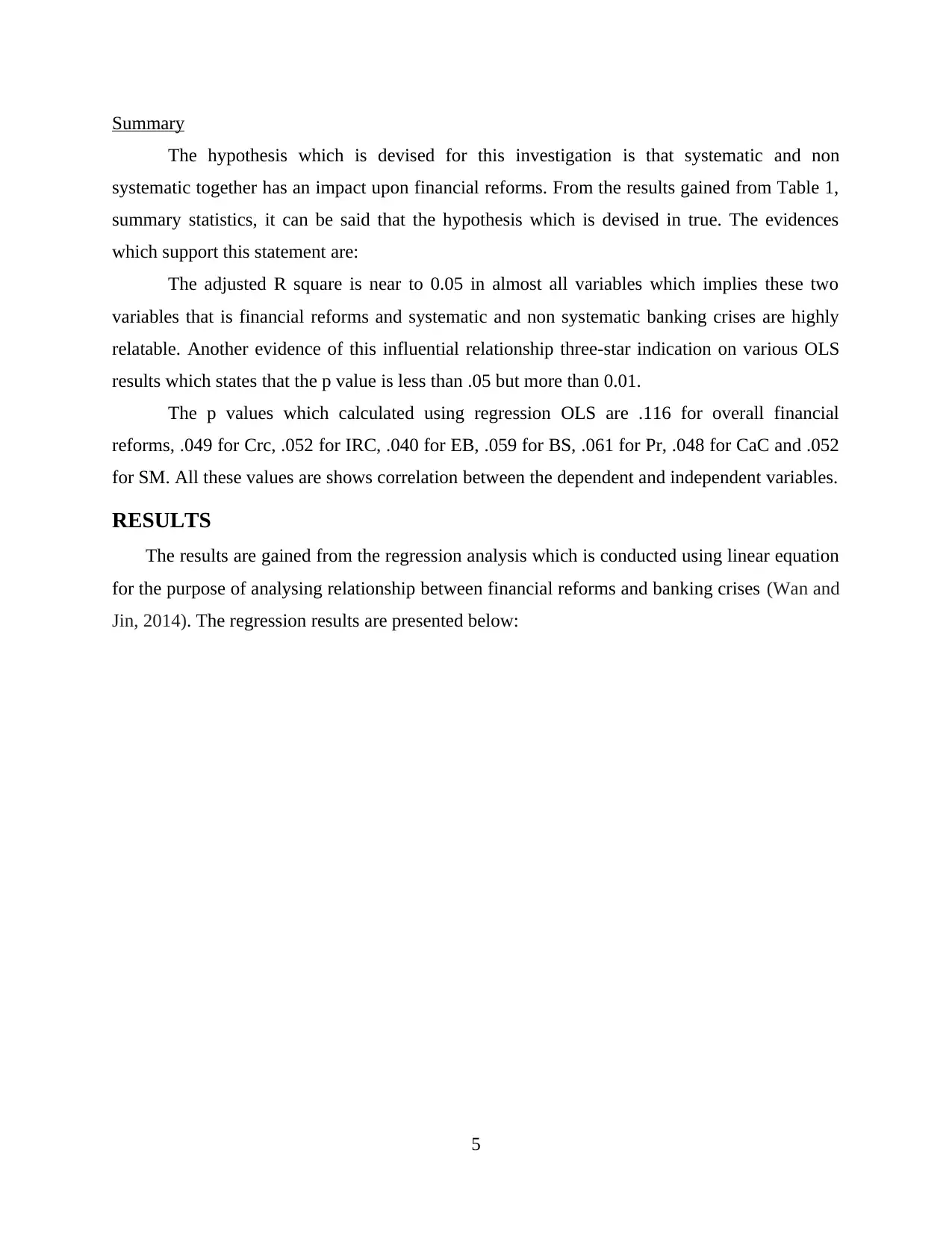
Summary
The hypothesis which is devised for this investigation is that systematic and non
systematic together has an impact upon financial reforms. From the results gained from Table 1,
summary statistics, it can be said that the hypothesis which is devised in true. The evidences
which support this statement are:
The adjusted R square is near to 0.05 in almost all variables which implies these two
variables that is financial reforms and systematic and non systematic banking crises are highly
relatable. Another evidence of this influential relationship three-star indication on various OLS
results which states that the p value is less than .05 but more than 0.01.
The p values which calculated using regression OLS are .116 for overall financial
reforms, .049 for Crc, .052 for IRC, .040 for EB, .059 for BS, .061 for Pr, .048 for CaC and .052
for SM. All these values are shows correlation between the dependent and independent variables.
RESULTS
The results are gained from the regression analysis which is conducted using linear equation
for the purpose of analysing relationship between financial reforms and banking crises (Wan and
Jin, 2014). The regression results are presented below:
5
The hypothesis which is devised for this investigation is that systematic and non
systematic together has an impact upon financial reforms. From the results gained from Table 1,
summary statistics, it can be said that the hypothesis which is devised in true. The evidences
which support this statement are:
The adjusted R square is near to 0.05 in almost all variables which implies these two
variables that is financial reforms and systematic and non systematic banking crises are highly
relatable. Another evidence of this influential relationship three-star indication on various OLS
results which states that the p value is less than .05 but more than 0.01.
The p values which calculated using regression OLS are .116 for overall financial
reforms, .049 for Crc, .052 for IRC, .040 for EB, .059 for BS, .061 for Pr, .048 for CaC and .052
for SM. All these values are shows correlation between the dependent and independent variables.
RESULTS
The results are gained from the regression analysis which is conducted using linear equation
for the purpose of analysing relationship between financial reforms and banking crises (Wan and
Jin, 2014). The regression results are presented below:
5
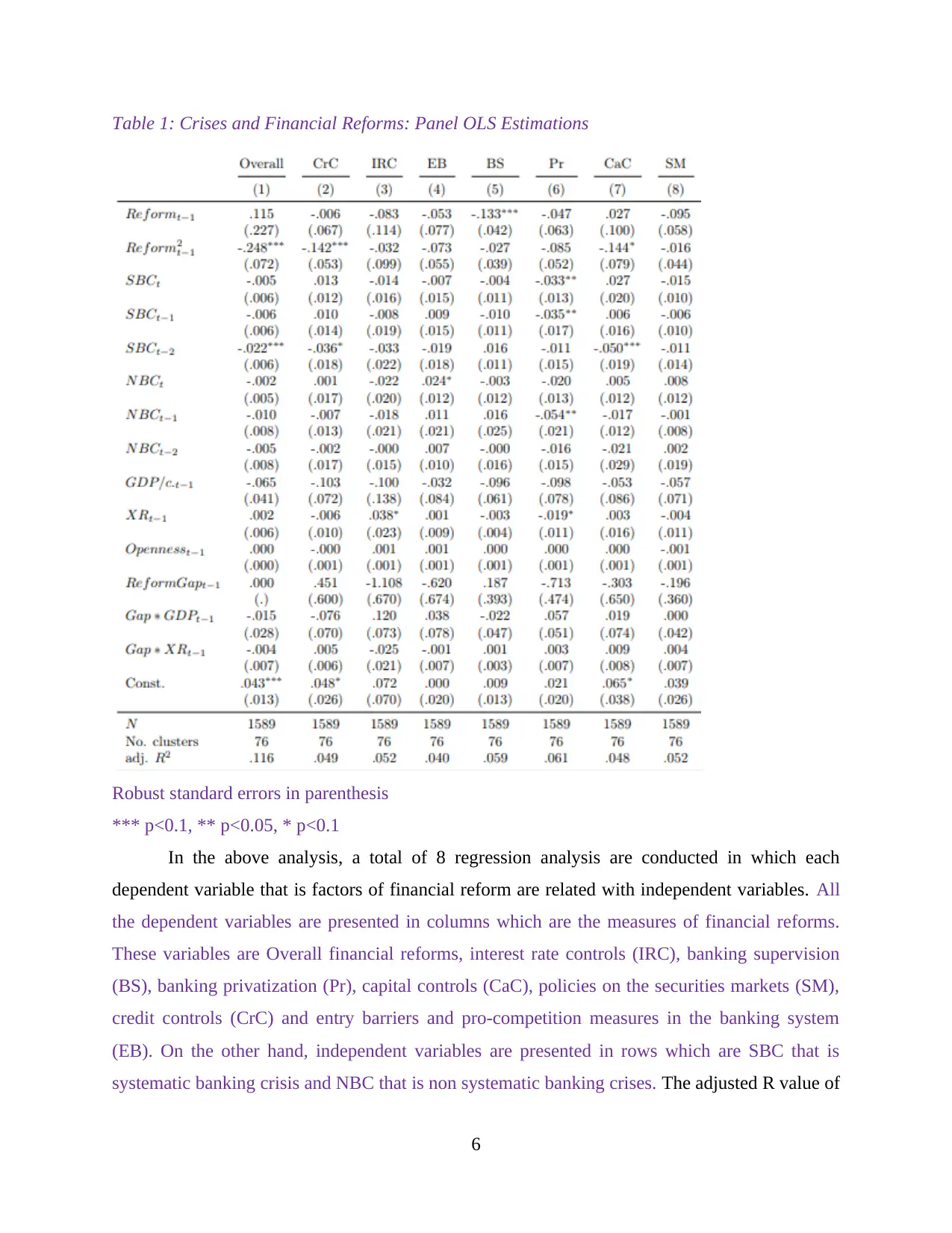
Table 1: Crises and Financial Reforms: Panel OLS Estimations
Robust standard errors in parenthesis
*** p<0.1, ** p<0.05, * p<0.1
In the above analysis, a total of 8 regression analysis are conducted in which each
dependent variable that is factors of financial reform are related with independent variables. All
the dependent variables are presented in columns which are the measures of financial reforms.
These variables are Overall financial reforms, interest rate controls (IRC), banking supervision
(BS), banking privatization (Pr), capital controls (CaC), policies on the securities markets (SM),
credit controls (CrC) and entry barriers and pro-competition measures in the banking system
(EB). On the other hand, independent variables are presented in rows which are SBC that is
systematic banking crisis and NBC that is non systematic banking crises. The adjusted R value of
6
Robust standard errors in parenthesis
*** p<0.1, ** p<0.05, * p<0.1
In the above analysis, a total of 8 regression analysis are conducted in which each
dependent variable that is factors of financial reform are related with independent variables. All
the dependent variables are presented in columns which are the measures of financial reforms.
These variables are Overall financial reforms, interest rate controls (IRC), banking supervision
(BS), banking privatization (Pr), capital controls (CaC), policies on the securities markets (SM),
credit controls (CrC) and entry barriers and pro-competition measures in the banking system
(EB). On the other hand, independent variables are presented in rows which are SBC that is
systematic banking crisis and NBC that is non systematic banking crises. The adjusted R value of
6
⊘ This is a preview!⊘
Do you want full access?
Subscribe today to unlock all pages.

Trusted by 1+ million students worldwide
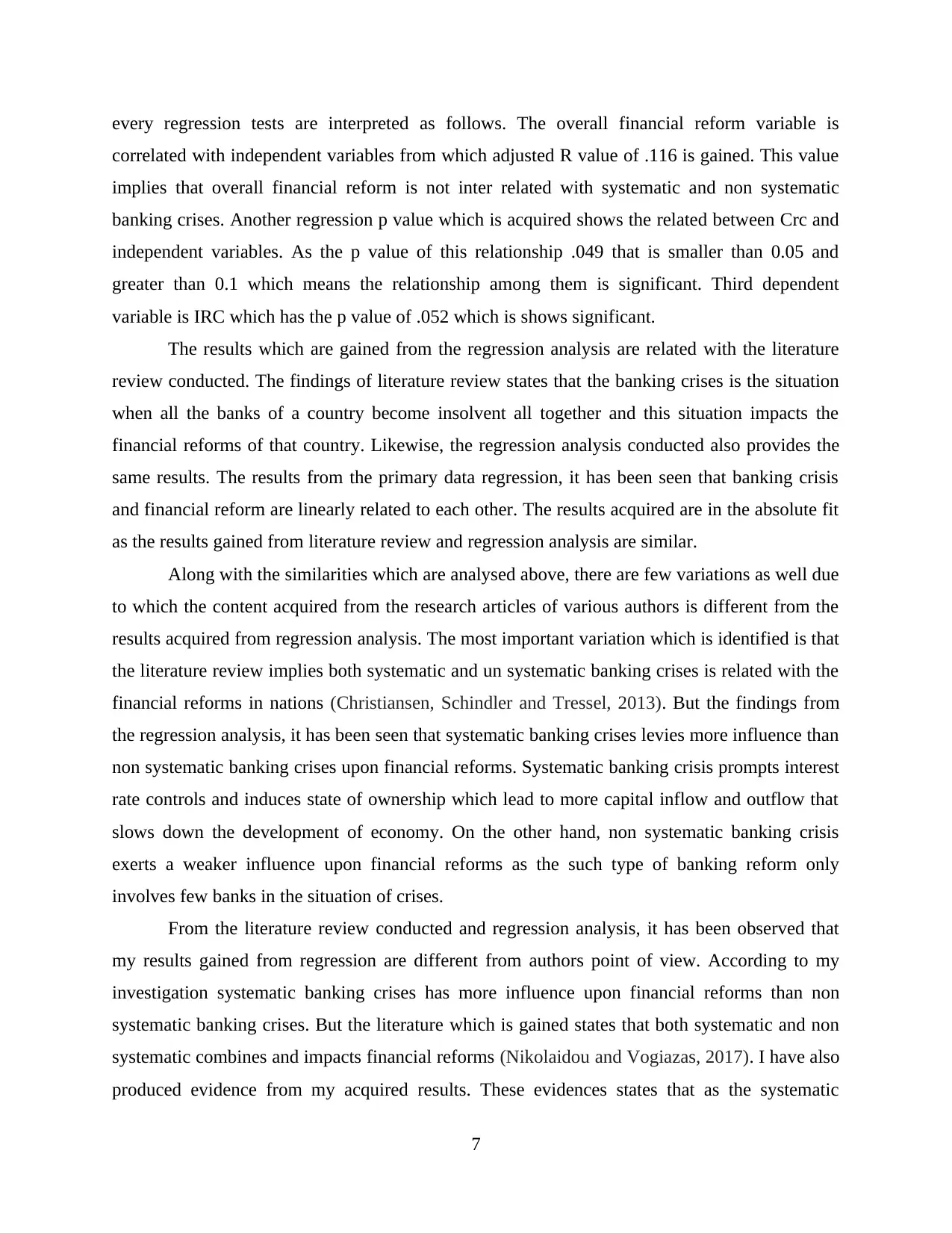
every regression tests are interpreted as follows. The overall financial reform variable is
correlated with independent variables from which adjusted R value of .116 is gained. This value
implies that overall financial reform is not inter related with systematic and non systematic
banking crises. Another regression p value which is acquired shows the related between Crc and
independent variables. As the p value of this relationship .049 that is smaller than 0.05 and
greater than 0.1 which means the relationship among them is significant. Third dependent
variable is IRC which has the p value of .052 which is shows significant.
The results which are gained from the regression analysis are related with the literature
review conducted. The findings of literature review states that the banking crises is the situation
when all the banks of a country become insolvent all together and this situation impacts the
financial reforms of that country. Likewise, the regression analysis conducted also provides the
same results. The results from the primary data regression, it has been seen that banking crisis
and financial reform are linearly related to each other. The results acquired are in the absolute fit
as the results gained from literature review and regression analysis are similar.
Along with the similarities which are analysed above, there are few variations as well due
to which the content acquired from the research articles of various authors is different from the
results acquired from regression analysis. The most important variation which is identified is that
the literature review implies both systematic and un systematic banking crises is related with the
financial reforms in nations (Christiansen, Schindler and Tressel, 2013). But the findings from
the regression analysis, it has been seen that systematic banking crises levies more influence than
non systematic banking crises upon financial reforms. Systematic banking crisis prompts interest
rate controls and induces state of ownership which lead to more capital inflow and outflow that
slows down the development of economy. On the other hand, non systematic banking crisis
exerts a weaker influence upon financial reforms as the such type of banking reform only
involves few banks in the situation of crises.
From the literature review conducted and regression analysis, it has been observed that
my results gained from regression are different from authors point of view. According to my
investigation systematic banking crises has more influence upon financial reforms than non
systematic banking crises. But the literature which is gained states that both systematic and non
systematic combines and impacts financial reforms (Nikolaidou and Vogiazas, 2017). I have also
produced evidence from my acquired results. These evidences states that as the systematic
7
correlated with independent variables from which adjusted R value of .116 is gained. This value
implies that overall financial reform is not inter related with systematic and non systematic
banking crises. Another regression p value which is acquired shows the related between Crc and
independent variables. As the p value of this relationship .049 that is smaller than 0.05 and
greater than 0.1 which means the relationship among them is significant. Third dependent
variable is IRC which has the p value of .052 which is shows significant.
The results which are gained from the regression analysis are related with the literature
review conducted. The findings of literature review states that the banking crises is the situation
when all the banks of a country become insolvent all together and this situation impacts the
financial reforms of that country. Likewise, the regression analysis conducted also provides the
same results. The results from the primary data regression, it has been seen that banking crisis
and financial reform are linearly related to each other. The results acquired are in the absolute fit
as the results gained from literature review and regression analysis are similar.
Along with the similarities which are analysed above, there are few variations as well due
to which the content acquired from the research articles of various authors is different from the
results acquired from regression analysis. The most important variation which is identified is that
the literature review implies both systematic and un systematic banking crises is related with the
financial reforms in nations (Christiansen, Schindler and Tressel, 2013). But the findings from
the regression analysis, it has been seen that systematic banking crises levies more influence than
non systematic banking crises upon financial reforms. Systematic banking crisis prompts interest
rate controls and induces state of ownership which lead to more capital inflow and outflow that
slows down the development of economy. On the other hand, non systematic banking crisis
exerts a weaker influence upon financial reforms as the such type of banking reform only
involves few banks in the situation of crises.
From the literature review conducted and regression analysis, it has been observed that
my results gained from regression are different from authors point of view. According to my
investigation systematic banking crises has more influence upon financial reforms than non
systematic banking crises. But the literature which is gained states that both systematic and non
systematic combines and impacts financial reforms (Nikolaidou and Vogiazas, 2017). I have also
produced evidence from my acquired results. These evidences states that as the systematic
7
Paraphrase This Document
Need a fresh take? Get an instant paraphrase of this document with our AI Paraphraser
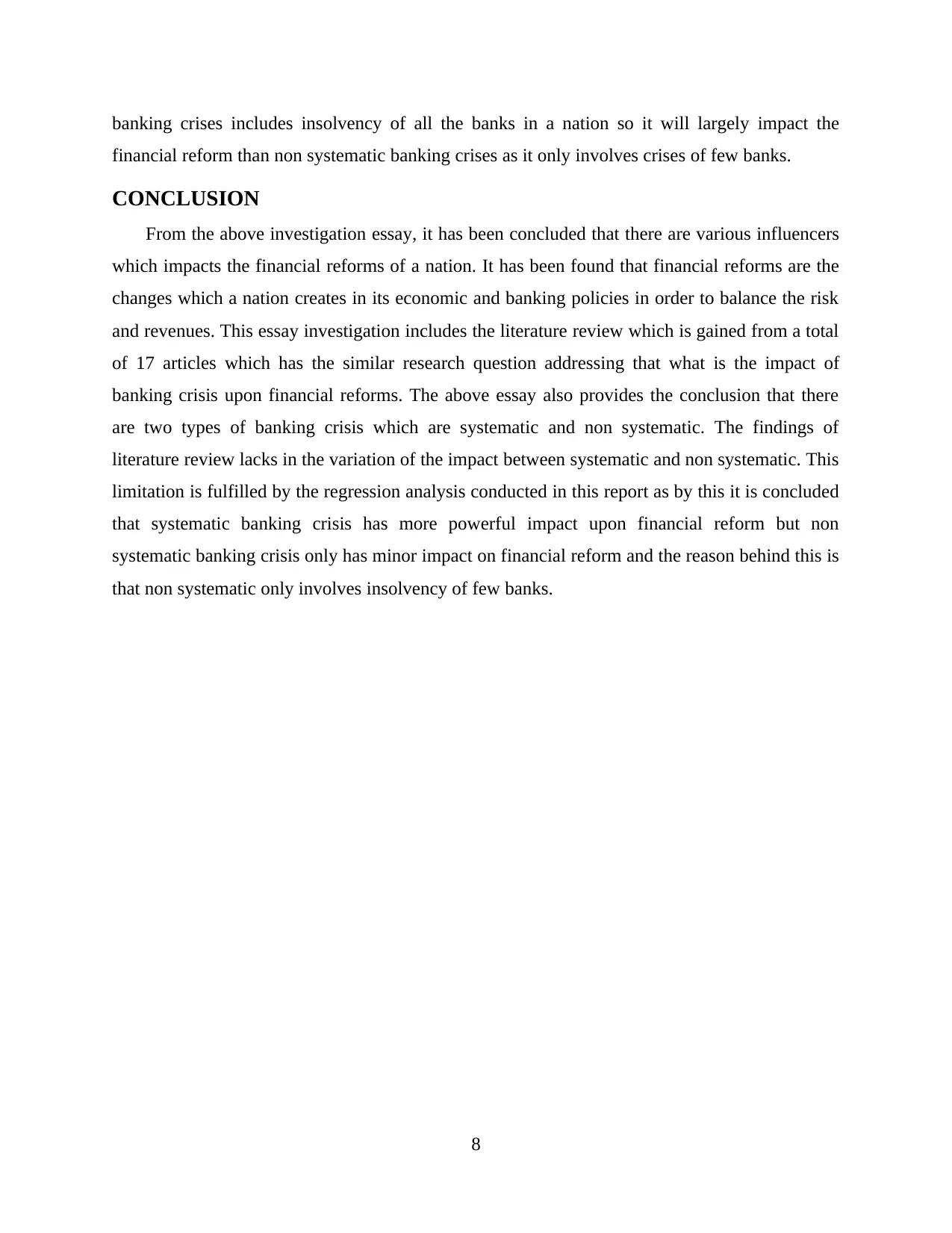
banking crises includes insolvency of all the banks in a nation so it will largely impact the
financial reform than non systematic banking crises as it only involves crises of few banks.
CONCLUSION
From the above investigation essay, it has been concluded that there are various influencers
which impacts the financial reforms of a nation. It has been found that financial reforms are the
changes which a nation creates in its economic and banking policies in order to balance the risk
and revenues. This essay investigation includes the literature review which is gained from a total
of 17 articles which has the similar research question addressing that what is the impact of
banking crisis upon financial reforms. The above essay also provides the conclusion that there
are two types of banking crisis which are systematic and non systematic. The findings of
literature review lacks in the variation of the impact between systematic and non systematic. This
limitation is fulfilled by the regression analysis conducted in this report as by this it is concluded
that systematic banking crisis has more powerful impact upon financial reform but non
systematic banking crisis only has minor impact on financial reform and the reason behind this is
that non systematic only involves insolvency of few banks.
8
financial reform than non systematic banking crises as it only involves crises of few banks.
CONCLUSION
From the above investigation essay, it has been concluded that there are various influencers
which impacts the financial reforms of a nation. It has been found that financial reforms are the
changes which a nation creates in its economic and banking policies in order to balance the risk
and revenues. This essay investigation includes the literature review which is gained from a total
of 17 articles which has the similar research question addressing that what is the impact of
banking crisis upon financial reforms. The above essay also provides the conclusion that there
are two types of banking crisis which are systematic and non systematic. The findings of
literature review lacks in the variation of the impact between systematic and non systematic. This
limitation is fulfilled by the regression analysis conducted in this report as by this it is concluded
that systematic banking crisis has more powerful impact upon financial reform but non
systematic banking crisis only has minor impact on financial reform and the reason behind this is
that non systematic only involves insolvency of few banks.
8
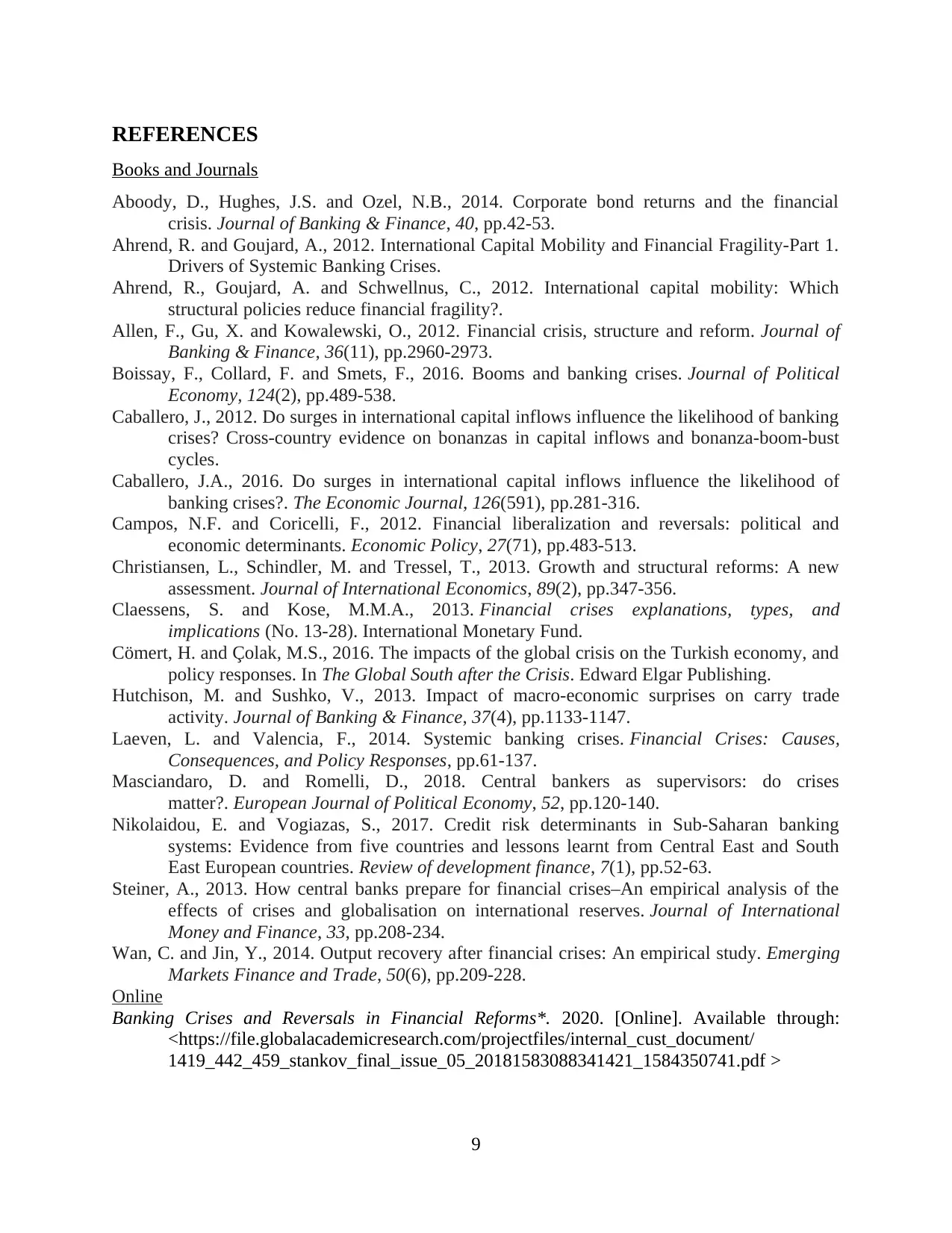
REFERENCES
Books and Journals
Aboody, D., Hughes, J.S. and Ozel, N.B., 2014. Corporate bond returns and the financial
crisis. Journal of Banking & Finance, 40, pp.42-53.
Ahrend, R. and Goujard, A., 2012. International Capital Mobility and Financial Fragility-Part 1.
Drivers of Systemic Banking Crises.
Ahrend, R., Goujard, A. and Schwellnus, C., 2012. International capital mobility: Which
structural policies reduce financial fragility?.
Allen, F., Gu, X. and Kowalewski, O., 2012. Financial crisis, structure and reform. Journal of
Banking & Finance, 36(11), pp.2960-2973.
Boissay, F., Collard, F. and Smets, F., 2016. Booms and banking crises. Journal of Political
Economy, 124(2), pp.489-538.
Caballero, J., 2012. Do surges in international capital inflows influence the likelihood of banking
crises? Cross-country evidence on bonanzas in capital inflows and bonanza-boom-bust
cycles.
Caballero, J.A., 2016. Do surges in international capital inflows influence the likelihood of
banking crises?. The Economic Journal, 126(591), pp.281-316.
Campos, N.F. and Coricelli, F., 2012. Financial liberalization and reversals: political and
economic determinants. Economic Policy, 27(71), pp.483-513.
Christiansen, L., Schindler, M. and Tressel, T., 2013. Growth and structural reforms: A new
assessment. Journal of International Economics, 89(2), pp.347-356.
Claessens, S. and Kose, M.M.A., 2013. Financial crises explanations, types, and
implications (No. 13-28). International Monetary Fund.
Cömert, H. and Çolak, M.S., 2016. The impacts of the global crisis on the Turkish economy, and
policy responses. In The Global South after the Crisis. Edward Elgar Publishing.
Hutchison, M. and Sushko, V., 2013. Impact of macro-economic surprises on carry trade
activity. Journal of Banking & Finance, 37(4), pp.1133-1147.
Laeven, L. and Valencia, F., 2014. Systemic banking crises. Financial Crises: Causes,
Consequences, and Policy Responses, pp.61-137.
Masciandaro, D. and Romelli, D., 2018. Central bankers as supervisors: do crises
matter?. European Journal of Political Economy, 52, pp.120-140.
Nikolaidou, E. and Vogiazas, S., 2017. Credit risk determinants in Sub-Saharan banking
systems: Evidence from five countries and lessons learnt from Central East and South
East European countries. Review of development finance, 7(1), pp.52-63.
Steiner, A., 2013. How central banks prepare for financial crises–An empirical analysis of the
effects of crises and globalisation on international reserves. Journal of International
Money and Finance, 33, pp.208-234.
Wan, C. and Jin, Y., 2014. Output recovery after financial crises: An empirical study. Emerging
Markets Finance and Trade, 50(6), pp.209-228.
Online
Banking Crises and Reversals in Financial Reforms*. 2020. [Online]. Available through:
<https://file.globalacademicresearch.com/projectfiles/internal_cust_document/
1419_442_459_stankov_final_issue_05_20181583088341421_1584350741.pdf >
9
Books and Journals
Aboody, D., Hughes, J.S. and Ozel, N.B., 2014. Corporate bond returns and the financial
crisis. Journal of Banking & Finance, 40, pp.42-53.
Ahrend, R. and Goujard, A., 2012. International Capital Mobility and Financial Fragility-Part 1.
Drivers of Systemic Banking Crises.
Ahrend, R., Goujard, A. and Schwellnus, C., 2012. International capital mobility: Which
structural policies reduce financial fragility?.
Allen, F., Gu, X. and Kowalewski, O., 2012. Financial crisis, structure and reform. Journal of
Banking & Finance, 36(11), pp.2960-2973.
Boissay, F., Collard, F. and Smets, F., 2016. Booms and banking crises. Journal of Political
Economy, 124(2), pp.489-538.
Caballero, J., 2012. Do surges in international capital inflows influence the likelihood of banking
crises? Cross-country evidence on bonanzas in capital inflows and bonanza-boom-bust
cycles.
Caballero, J.A., 2016. Do surges in international capital inflows influence the likelihood of
banking crises?. The Economic Journal, 126(591), pp.281-316.
Campos, N.F. and Coricelli, F., 2012. Financial liberalization and reversals: political and
economic determinants. Economic Policy, 27(71), pp.483-513.
Christiansen, L., Schindler, M. and Tressel, T., 2013. Growth and structural reforms: A new
assessment. Journal of International Economics, 89(2), pp.347-356.
Claessens, S. and Kose, M.M.A., 2013. Financial crises explanations, types, and
implications (No. 13-28). International Monetary Fund.
Cömert, H. and Çolak, M.S., 2016. The impacts of the global crisis on the Turkish economy, and
policy responses. In The Global South after the Crisis. Edward Elgar Publishing.
Hutchison, M. and Sushko, V., 2013. Impact of macro-economic surprises on carry trade
activity. Journal of Banking & Finance, 37(4), pp.1133-1147.
Laeven, L. and Valencia, F., 2014. Systemic banking crises. Financial Crises: Causes,
Consequences, and Policy Responses, pp.61-137.
Masciandaro, D. and Romelli, D., 2018. Central bankers as supervisors: do crises
matter?. European Journal of Political Economy, 52, pp.120-140.
Nikolaidou, E. and Vogiazas, S., 2017. Credit risk determinants in Sub-Saharan banking
systems: Evidence from five countries and lessons learnt from Central East and South
East European countries. Review of development finance, 7(1), pp.52-63.
Steiner, A., 2013. How central banks prepare for financial crises–An empirical analysis of the
effects of crises and globalisation on international reserves. Journal of International
Money and Finance, 33, pp.208-234.
Wan, C. and Jin, Y., 2014. Output recovery after financial crises: An empirical study. Emerging
Markets Finance and Trade, 50(6), pp.209-228.
Online
Banking Crises and Reversals in Financial Reforms*. 2020. [Online]. Available through:
<https://file.globalacademicresearch.com/projectfiles/internal_cust_document/
1419_442_459_stankov_final_issue_05_20181583088341421_1584350741.pdf >
9
⊘ This is a preview!⊘
Do you want full access?
Subscribe today to unlock all pages.

Trusted by 1+ million students worldwide
1 out of 12
Related Documents
Your All-in-One AI-Powered Toolkit for Academic Success.
+13062052269
info@desklib.com
Available 24*7 on WhatsApp / Email
![[object Object]](/_next/static/media/star-bottom.7253800d.svg)
Unlock your academic potential
Copyright © 2020–2025 A2Z Services. All Rights Reserved. Developed and managed by ZUCOL.



